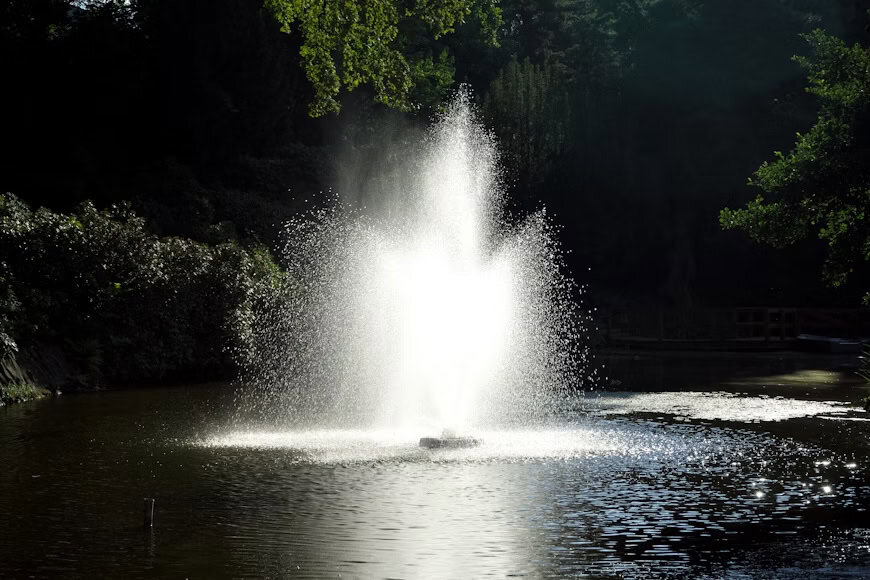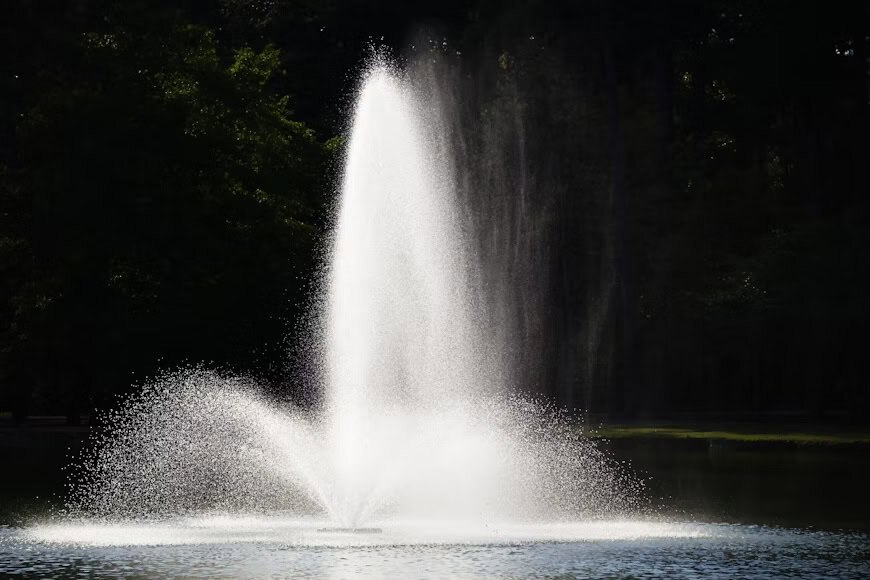Imagine walking into your backyard and hearing the gentle, soothing sound of water flowing. There’s something almost magical about water features that can transform an ordinary garden into a peaceful retreat. But behind that tranquility lies a key component many people overlook until something goes wrong.
Submersible fountain pumps are the workhorses that power those beautiful water displays. These pumps sit completely underwater, pushing water up through fountain heads to create everything from gentle bubbling to dramatic sprays. Yet many buyers rush this purchase, ending up with pumps that burn out quickly, make irritating noises, or simply can’t produce the water effects they wanted.
The right submersible fountain pumps make all the difference between a stunning water feature that becomes the centerpiece of your garden and a frustrating eyesore that sits unused. Making the wrong choice not only wastes money but can lead to endless maintenance headaches and even damage to other components of your water feature.
Before diving into pump specifications, take a moment to consider what’s really at stake. A properly functioning fountain doesn’t just look pretty, it creates an atmosphere, reduces stress, and even increases property value. Many homeowners spend thousands on landscaping only to have their vision ruined by cutting corners on the pump that powers it all.
Choosing a fountain pump might seem simple at first glance. Just pick one that moves water, right? Not quite. The wrong pump can leave you with disappointment, wasted money, and even water damage to surrounding areas.
Let’s break down what really matters when selecting a submersible pump for your fountain:
Flow Rate and Head Height
The flow rate (measured in gallons per hour or GPH) tells you how much water moves through the pump. This determines how dramatic your fountain display will be.
Too little flow, and your fountain looks weak and unimpressive. Too much, and water might splash outside the basin, requiring constant refilling and potentially damaging surrounding areas.
Head height refers to maximum height the pump can push water vertically. This measurement becomes crucial when planning taller fountains or water features with multiple tiers.
Many buyers make the mistake of buying a pump with insufficient head height. The result? A pump that struggles, overheats, and fails prematurely.
A good rule of thumb: For each foot of height you want water to reach, add about 1.5 feet to account for pressure loss through tubing and fittings. For example, if you want water to shoot 3 feet high, look for a pump with at least 4.5 feet of head height capability.
Perhaps more important to look for is the “pump curve.” This is a measure of how many gallons per hour the pump will pump at different heights. For example, a 250 gallon per hour pump will pump less that that at two feet of rise, and less again at three feet of rise, etc. Look at the pump specifications and a pump curve should be included.
Power Consumption
Fountain pumps often run continuously, so their energy usage directly impacts your electric bill. The cheapest pump often costs more in the long run through higher energy consumption.
Look for pumps with low wattage ratings relative to their GPH output. Some newer models include energy-efficient features like adjustable flow rates that let you reduce power consumption when full flow isn’t needed.
Reliability and Maintenance
Nothing ruins the peaceful atmosphere of a water feature faster than a pump that constantly needs attention. Quality pumps include features that reduce maintenance:
– Pre-filters that prevent debris from clogging the impeller
– Ceramic shafts that resist wear better than plastic versions
– Epoxy-sealed motors that prevent water intrusion
– Thermal overload protection that prevents burnout
The time you spend maintaining a cheap pump quickly outweighs any initial savings. Better pumps might cost more upfront, but save countless hours of frustration.
Some garden owners learn this lesson the hard way. Buying three or four budget pumps over a season when one quality pump would have lasted years.
Noise Level
Most people want fountains for relaxation, yet many overlook pump noise when making a purchase. A noisy pump defeats the whole purpose of a tranquil water feature.
Quality submersible pumps operate almost silently. Cheaper models often produce annoying hums or vibrations that carry through the water and surrounding structure.
The noise isn’t just about quality, proper sizing matters too. An undersized pump running at maximum capacity makes more noise than an appropriately sized one running at moderate levels.
Installation Considerations

Before finalizing your pump selection, think about practical installation factors:
Cord Length
Standard cords run 6-25 feet. But for fountains several hundred feet away, cord lengths might reach 500’, depending on the manufacturer. Measure the distance to your nearest outdoor outlet before buying. Extension cords aren’t recommended for permanent water feature installations due to safety concerns.
Outlet Diameter
Make sure the pump’s outlet size matches your fountain’s tubing or can be adapted easily. Reducing the outlet size increases pressure but decreases flow volume.
Adjustable Flow
Pumps with adjustable flow rates give you flexibility in creating different water effects without replacing the entire pump.
Special Features Worth Considering

Some newer submersible pumps include features that might be worth the extra cost:
LED Lighting
Pumps with built-in LED lighting create stunning nighttime displays without additional wiring.
Solar Options
Solar-powered pumps eliminate electricity costs but typically offer lower flow rates and depend on adequate sunlight.
Smart Controls
Some premium models connect to smartphone apps, allowing programming of fountain displays and monitoring pump performance.
Common Pitfalls to Avoid

When shopping for submersible fountain pumps, watch out for these frequent mistakes:
- Buying based solely on price. The cheapest pump almost always costs more through replacements, energy usage, and maintenance time.
- Undersizing. A slightly too-powerful pump can be adjusted down, but an underpowered pump can’t be adjusted up.
- Ignoring warranty and warning signs. Quality manufacturers stand behind their products with meaningful warranties, not just 30-day guarantees.
- Forgetting about winter. In cold climates, pumps need proper winterization or replacement each spring.
Making Your Final Decision

After considering all these factors, you’re in a much better position to choose the right submersible pump. Remember that your fountain is meant to be enjoyed, not become a source of ongoing frustration.
The perfect pump strikes a balance between performance, efficiency, durability, and cost. Sometimes spending a bit more upfront saves significant money and headaches down the road.
Your garden deserves a water feature that enhances its beauty rather than becoming a maintenance burden. Take the time to choose wisely, and you’ll enjoy the soothing sounds of your fountain for years to come. Ready to enhance your fountain setup? Explore our website to see how we can help!
Frequently Asked Questions
How often do submersible fountain pumps need to be cleaned?
Quality pumps typically need cleaning every 1-3 months, depending on your water conditions and debris level. Ponds with lots of leaves or algae may require more frequent cleaning. Always unplug the pump before maintenance and follow the manufacturer’s specific cleaning instructions.
Can submersible pumps run dry without damage?
No. Running a submersible pump without water quickly damages the motor and seals. Most quality pumps have built-in protection that shuts them down if water levels drop too low, but this shouldn’t be relied upon as a regular operating condition. Always ensure your pump remains fully submerged.
What’s the typical lifespan of a good submersible fountain pump?
A quality submersible pump should last 2-5 years with proper maintenance. Premium models can last even longer. Factors affecting lifespan include water quality, operating conditions, and maintenance frequency. Pumps that run continuously at maximum capacity typically wear out faster than those operating at moderate levels.
Is it normal for my new pump to make noise when first installed?
Some minor noise is normal during the first 24-48 hours as air works its way out of the system. After this break-in period, a quality submersible pump should operate very quietly. Persistent noise usually indicates improper installation, air leaks, or possibly a defective unit that should be returned.
Featued Image Source : https://images.unsplash.com/photo-1495874544969-f7bb3b4f52f3?ixlib=rb-4.1.0&ixid=M3wxMjA3fDB8MHxwaG90by1wYWdlfHx8fGVufDB8fHx8fA%3D%3D&auto=format&fit=crop&q=80&w=870


